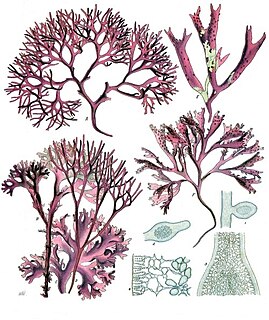
Chondrus crispus—commonly called Irish moss or carrageen moss —is a species of red algae which grows abundantly along the rocky parts of the Atlantic coast of Europe and North America. In its fresh condition this protist is soft and cartilaginous, varying in color from a greenish-yellow, through red, to a dark purple or purplish-brown. The principal constituent is a mucilaginous body, made of the polysaccharide carrageenan, which constitutes 55% of its dry weight. The organism also consists of nearly 10% dry weight protein and about 15% dry weight mineral matter, and is rich in iodine and sulfur. When softened in water it has a sea-like odour and because of the abundant cell wall polysaccharides it will form a jelly when boiled, containing from 20 to 100 times its weight of water.
Carrageenans or carrageenins are a family of natural linear sulfated polysaccharides that are extracted from red edible seaweeds. The most well-known and still most important red seaweed used for manufacturing the hydrophilic colloids to produce carrageenan is Chondrus crispus which is a dark red parsley-like plant that grows attached to the rocks. Carrageenans are widely used in the food industry, for their gelling, thickening, and stabilizing properties. Their main application is in dairy and meat products, due to their strong binding to food proteins. In recent years, carrageenans have emerged as a promising candidate in tissue engineering and regenerative medicine applications as they resemble native glycosaminoglycans (GAGs). They have been mainly used for tissue engineering, wound coverage and drug delivery.

Caulerpa is a genus of seaweeds in the family Caulerpaceae. They are unusual because they consist of only one cell with many nuclei, making them among the biggest single cells in the world. A species in the Mediterranean can have a stolon more than 3 metres (9.8 ft) long, with up to 200 fronds. This species can be invasive from time to time.

Mastocarpus stellatus, commonly known as carrageenan moss or false Irish moss, is a species in the Rhodophyceae division, a red algae seaweed division, and the Phyllophoracea family. M. stellatus is closely related to Irish Moss. It grows in the intertidal zone. It is most collected in North Atlantic regions such as Ireland and Scotland, together with Irish moss, dried, and sold for cooking and as the basis for a drink reputed to ward off colds and flu. Marine biologists have completed studies on the medicinal reputation of M. stellatus to discover the full potential of its pharmaceutical benefits. Additionally, marine biologists have conducted research on its potential to serve as an alternative to plastic. The application of M. stellatus in these different industries is correlated with the seaweed's adaptations which developed in response to the environmental stressors present around its location on the rocky intertidal.

Gelidium is a genus of thalloid red algae comprising 134 species. Its members are known by a number of common names.

Kappaphycus alvarezii, the elkhorn sea moss, is a species of red algae. It is one of the most important commercial sources of carrageenans, a family of gel-forming, viscosifying polysaccharides. Farming methods affect the character of the carrageenan that can be extracted from the seaweed.

Gulaman, in Filipino cuisine, is a bar, or powdered form, of dried agar or carrageenan used to make jelly-like desserts. In common usage, it also usually refers to the refreshment sago't gulaman, sometimes referred to as samalamig, sold at roadside stalls and vendors.

Seaweed, or macroalgae, refers to thousands of species of macroscopic, multicellular, marine algae. The term includes some types of Rhodophyta (red), Phaeophyta (brown) and Chlorophyta (green) macroalgae. Seaweed species such as kelps provide essential nursery habitat for fisheries and other marine species and thus protect food sources; other species, such as planktonic algae, play a vital role in capturing carbon, producing at least 50% of Earth's oxygen.

Red algae, or Rhodophyta, are one of the oldest groups of eukaryotic algae. The Rhodophyta also comprises one of the largest phyla of algae, containing over 7,000 currently recognized species with taxonomic revisions ongoing. The majority of species (6,793) are found in the Florideophyceae (class), and mostly consist of multicellular, marine algae, including many notable seaweeds. Red algae are abundant in marine habitats but relatively rare in freshwaters. Approximately 5% of red algae species occur in freshwater, environments with greater concentrations found in warmer areas. Except for two coastal cave dwelling species in the asexual class Cyanidiophyceae, there are no terrestrial species, which may be due to an evolutionary bottleneck in which the last common ancestor lost about 25% of its core genes and much of its evolutionary plasticity.

Edible seaweed, or sea vegetables, are seaweeds that can be eaten and used for culinary purposes. They typically contain high amounts of fiber. They may belong to one of several groups of multicellular algae: the red algae, green algae, and brown algae. Seaweeds are also harvested or cultivated for the extraction of polysaccharides such as alginate, agar and carrageenan, gelatinous substances collectively known as hydrocolloids or phycocolloids. Hydrocolloids have attained commercial significance, especially in food production as food additives. The food industry exploits the gelling, water-retention, emulsifying and other physical properties of these hydrocolloids.
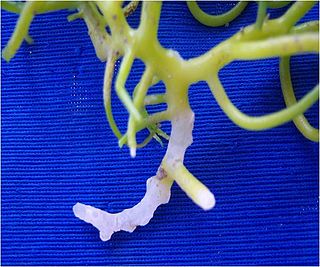
Ice-ice is a disease condition of seaweed. Ice-ice is caused when changes in salinity, ocean temperature and light intensity cause stress to seaweeds, making them produce a "moist organic substance" that attracts bacteria in the water and induces the characteristic "whitening" and hardening of the seaweed's tissues. Bacteria involved include those in the Vibrio-Aeromonas and Cytophaga-Flavobacteria complexes. The bacteria lyse epidermal cells and chloroplasts, turning the seaweed tissue white. The disease is known from seaweeds including Kappaphycus alvarezii and Eucheuma denticulatum, economically important sources of carrageenan. In countries where seaweed is harvested as a crop, ice-ice can wreak havoc on yields. Zamboanga, Philippines, had an outbreak of ice-ice in 2004, and Bali, Indonesia, experienced an outbreak in 2009. A rise in surface sea temperatures of 2–3 degrees Celsius can trigger ice-ice outbreaks.

Seaweed farming or kelp farming is the practice of cultivating and harvesting seaweed. In its simplest form, it consists of the management of naturally found batches. In its most advanced form, it consists of fully controlling the life cycle of the algae. The top seven most cultivated seaweed taxa are Eucheuma spp., Kappaphycus alvarezii, Gracilaria spp., Saccharina japonica, Undaria pinnatifida, Pyropia spp., and Sargassum fusiforme. Eucheuma and K. alvarezii are farmed for carrageenan ; Gracilaria is farmed for agar; while the rest are farmed for food. The largest seaweed-producing countries are China, Indonesia, and the Philippines. Other notable producers include South Korea, North Korea, Japan, Malaysia, and Zanzibar (Tanzania). Seaweed farming has frequently been developed as an alternative to improve economic conditions and to reduce fishing pressure and overexploited fisheries.
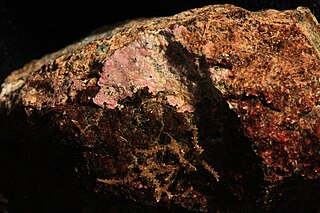
Hildenbrandia is a genus of thalloid red alga comprising about 26 species. The slow-growing, non-mineralized thalli take a crustose form. Hildenbrandia reproduces by means of conceptacles and produces tetraspores.

Eucheuma, commonly known as gusô, is a rhodophyte seaweed that may vary in color. Eucheuma species are used in the production of carrageenan, an ingredient for cosmetics, food processing, and industrial manufacturing, as well as a food source for people in the Philippines and parts of Indonesia and Malaysia. Eucheuma cottonii – cultivated in the Philippines – is the particular species known as gusô. Other species include Betaphycus gelatinae, Eucheuma denticulatum, and several species of the genus Kappaphycus, including K. alvarezii. Since the mid-1970s, Kappaphycus and Eucheuma have been a major source for the expansion of the carrageenan industry.
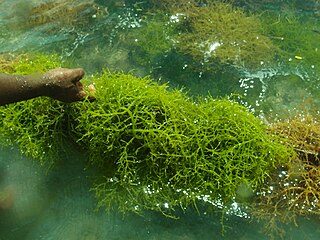
Eucheuma denticulatum is a species of red algae and one of the primary sources of iota carrageenan. It exists naturally in the Philippines, tropical Asia, and the western Pacific, but for the commercial extraction of carrageenan it is usually cultivated. The species is commonly known as E. spinosum when cultivated and can be found in different colours: brown, green and red.

Gavino Trono Jr., Ph.D. is a Filipino marine biologist dubbed as the "Father of Kappaphycus farming". He was conferred the rank of National Scientist of the Philippines for contributions to the study of tropical marine phycology, focusing on seaweed biodiversity. He is currently a professor emeritus of the University of the Philippines Marine Science Institute.

Hypnea is a genus of red algae, and a well known carrageenophyte.

Furcellaria is a genus of red algae. It is a monotypic genus, the only species being Furcellaria lumbricalis, which has commercial importance as a raw material for carrageenan production. It is mainly harvested from the waters of Denmark and Canada.

Batrachospermaceae is a family of fresh water red algae (Rhodophyta). Genera within the Batrachospermaceae generally have a "Lemanea-type" life history with carpospores germinating to produce chantransia. Sporophyte phase with meiosis occurs in an apical cell to produce the gametophyte stage. Pit connections have two pit plug cap layers with the other layer enlarged. This family of freshwater red algae is uniaxial, meaning each filament with a single apical cell. The genera included within Batrachospermaceae are listed in the table below.
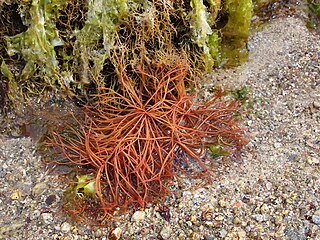
The Gracilariaceae is a small family of red algae containing several genera of agarophytes. It has a world-wide distribution. 24 species are found in China, and 6 species are found in Great Britain and Ireland. It is found in Australia and Chile.
















